Race Analysis: Carson City Off-Road with Keegan Swenson – Ask a Cycling Coach 162
50 miles in three and a half hours may not sound impressive to your average road racer, but digging into the details of Keegan Swenson’s 2nd place ride at the Epic Rides Carson City Off-Road, it’s clear this is a world-class performance.
The Carson City Off-Road has 15-, 35- and 50-mile variants for amateurs, and a 50-mile race as the only option for the pros. The race is known for high elevation and picturesque views of Lake Tahoe, but it’s variable weather and brutally long climbs may soon carry the event’s banner.
Keegan’s Background
Keegan Swenson is one of the fastest XC mountain bikers in the USA, an Olympic hopeful and guaranteed contender for the National Championship. At 142lbs (64.4kg) you’d expect Keegan to be a good climber, and he is, but his threshold sits just below a massive 400 watts, so he has plenty of power for all situations.
In addition to his climbing chops, Keegan is known for being a great descender. Growing up a ski racer and riding on Park City, UT singletrack no doubt contributes to his descending prowess.
Equipment Choices
Keegan rides for the Stans / Pivot Pro Team presented by Maxxis, and for Carson City Off-Road he chose to ride the Pivot LES 29 with a thoroughly thought out list of components and adjustments.
Keegan opted to run Maxxis Aspen 29×2.25 tires with EXO protection. This extra sidewall protection comes with a weight penalty of about 120 grams, but that should add up to no more than a handful of seconds over the course of the race, while a flat tire could have added minutes. The course is predominantly sandy and smooth, but occasional sharp rocks had smart riders taking the “better safe than sorry” approach. Keegan uses Stan’s Race Sealant to give him even more insurance of avoiding an irreparable puncture, and he carries one large CO2.
Helping keep the weight down were his Stan’s Podium SRD wheels, which come in below 1,300 grams, his ultralight Fox Stepcast 32 fork (75 psi with 2 volume spacers), and Shimano’s XTR Di2 drivetrain. For his power meter, Keegan uses a Stages single-sided XTR M9020 power meter paired with the Stages Dash head unit. Keegan finds this head unit’s landscape mode to be particularly useful for keeping it out of harm’s way while mountain biking.
The Carson City Off-Road has a wide variance in speed with sustained periods of pedaling around 25 mph and 15% fire road climbs, so Keegan chose a 36 tooth chainring with the 11-40 XTR cassette.
In terms of small modifications, tools and spares, Keegan is known for optimizing every detail. Like many of the top American XC racers, he uses TOGS, which are small hooks for your thumbs that allow you a different hand position when climbing. He tapes a quick-link on his handlebars along with small, pre-threaded Genuine Innovations tire plugs to allow for immediate access. He also carries a Pro multi-tool with chain breaker, a spare tube and CO2s all taped to his downtube just below his bottle cage.
Although Keegan is racing with 29″ wheels, he only carries a 27.5″ tube with him. Considering the tube is just a “Plan C” if the hole in his tire is too large for sealant and tire plugs, he’s found the 27.5″ tube works fine while being lighter and taking up less room.
When taping all of this to his downtube, he is sure to leave a small flap of tape that he can quickly pull to get easy access to all the items he is carrying.
Nutrition Strategy
Carson City Off-Road has three aid stations and Keegan had help from team staff and family at each. GU is Keegan’s nutrition company of choice, and he used their Gels, Chews and Hydration mix with some clever twists.
Every bottle that Keegan grabs has a GU Gel taped to its lid, requiring him to carry less weight and making it easy to remember to take in his calories with regularity.
Keegan prefers to have one bottle of GU’s Hydration Mix followed by one bottle of water, and since the aid stations were conveniently placed, he only installed one bottle cage and carried one bottle at a time to save weight. He anticipated getting 70 Calories from each bottle of mix, then took in the rest of his calories from two full packs of GU Chews and Gels.
Keegan burned 3,700 calories on the day, but a combination of pancakes for breakfast two and a half hours before the race, eating something every 20 minutes and drinking his bottle of mix before every aid station kept him fueled for the day.
Mountain Bikes and Power Meters
People often question the efficacy of power meters for mountain biking because of the highly variable effort needed to negotiate typical MTB terrain, but power meters are equally valuable on road or dirt.
However, the one thing you do have to consider when analyzing a mountain bike power file is how much time is spent coasting due to descents. This drags the power data very low compared to a typical power file from the road, and depending on the course, it is common to see anywhere from a 5-10% reduction in Normalized and Average power from what you would typically expect for a given effort.
With that in mind, let’s analyze Keegan’s race.
Why MTB Races Start Hard
One of Keegan’s strongest competitors is current National Champion Howard Grotts. He’s known for his extraordinary climbing ability, and Carson City Off-Road started with a hard fireroad climb into a tight four and a half miles of singletrack climbing.
Keegan was hoping to go as hard as needed before the singletrack to keep Howard behind him, allowing Keegan to dictate the pace rather than Howard. The fight for position before singletrack is always important and comes at a great physiological cost, but this is especially bold considering they had a 50-mile course with plenty of climbing ahead.
This chase to the singletrack ended up being a 375w effort for 10:00 minutes, which is roughly what Keegan could sustain for an hour at the race start elevation, but they still had plenty of racing left. While Keegan didn’t end up getting in front of Howard going into the singletrack, the move was enough to give he and Howard a gap over the rest of the field.
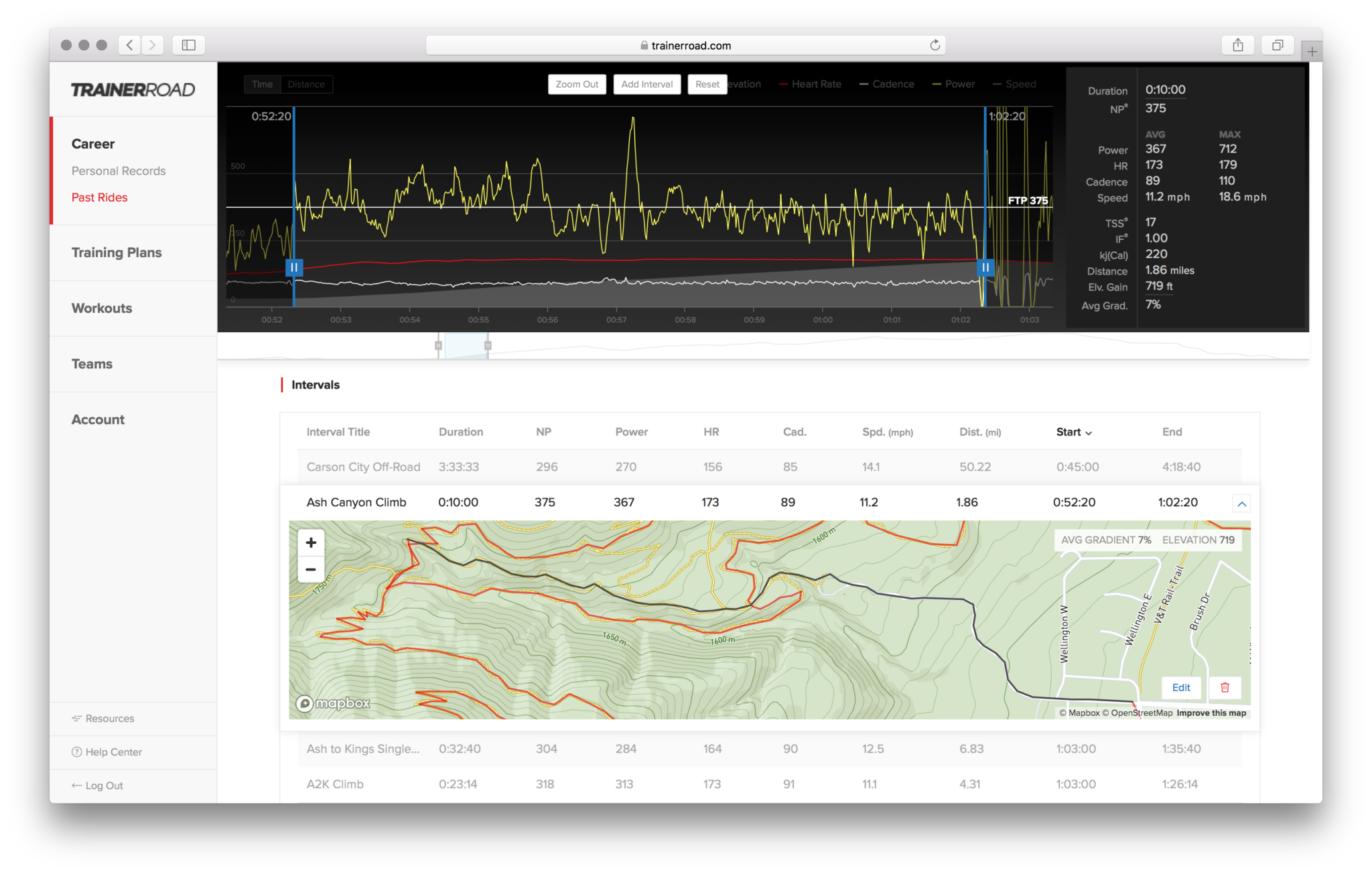
At this point they weren’t even five miles into the race, but Keegan’s exceptional fitness already starts to show. After riding over and around Threshold for 10 minutes, Keegan continued to be able to cross his threshold an astonishing 141 times in the next 23 minutes on the Ash to Kings singletrack climb, spending just shy of 20% of that time above Threshold.
World class mountain bikers like Keegan have cultivated an incredible ability to recover quickly from hard efforts, and that recovery is accomplished without the need to coast. With fitness like this, Keegan can start races hard enough to cause a separation without fearing a premature blowup.
Pro Mountain Bikers and Coasting
In our analysis of Geoff Kabush’s Dirty Kanza race, we noticed his rides mirrored that of many pro road racers in that they spend a surprisingly large amount of time coasting. Mountain biking, however, is a different story.
Keeping in mind the nearly 7,000 vertical feet of descending on this course, Keegan coasted for 24 minutes during this three and a half hour race. 10% of his race time may seem like a lot, but as a point of comparison, our CEO Nate Pearson coasted for nearly an hour and a half (26% of his race).
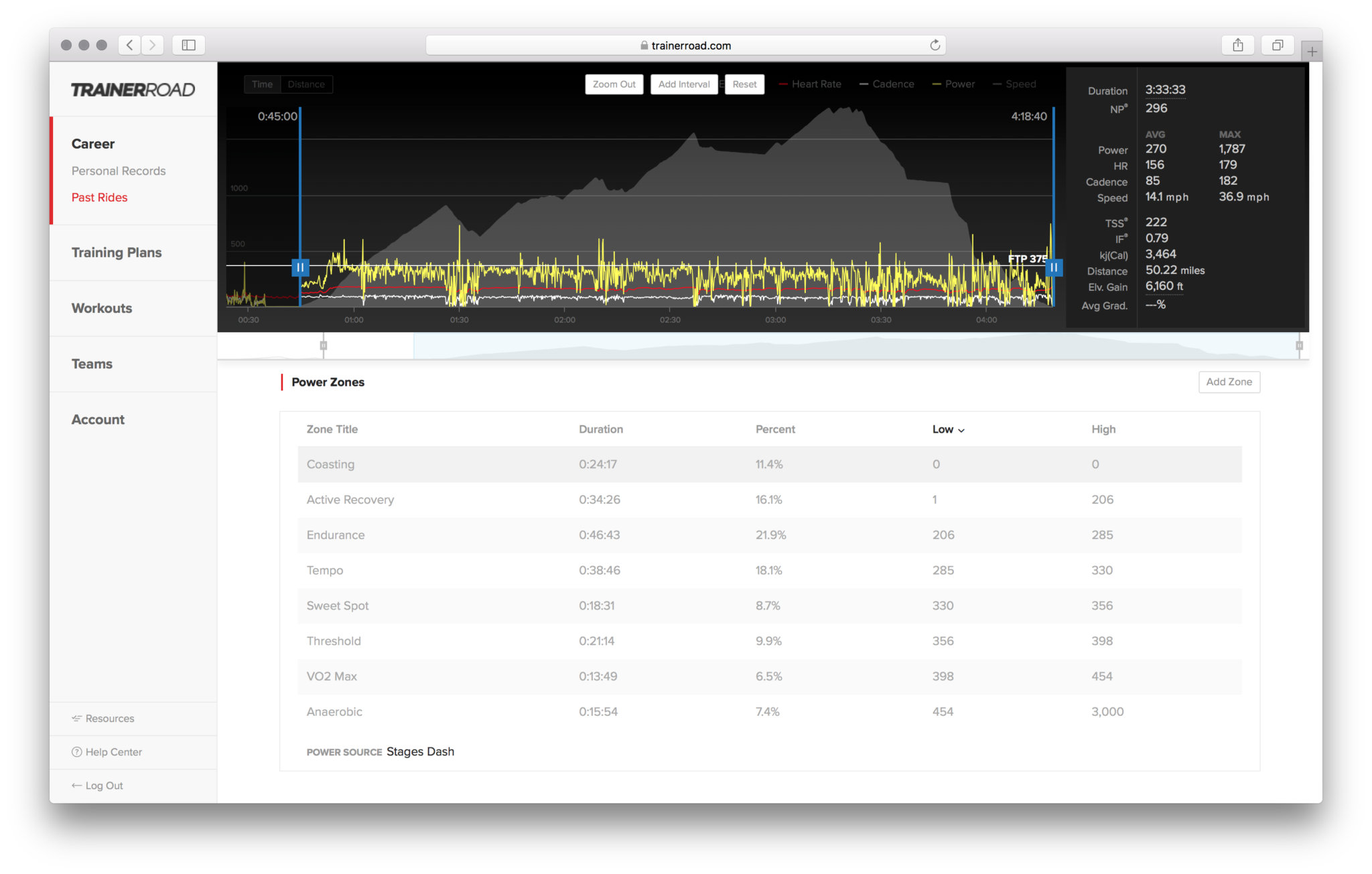
The reason pro mountain bike racers coast less than what you’d see in a road race is preservation of momentum. The variable terrain of a mountain bike race is rife with opportunities to lose momentum, but maintaining a certain threshold of speed throughout the course can help you carry speed through these undulations and save more energy.
However, looking at Keegan’s race file it seems that he still takes advantage of consistent descents to coast, and perhaps even more than average riders. Once again, the keen sense of kinetic energy is a common trait amongst successful racers.
Descending Isn’t Supposed to Be Easy
Whereas average riders tend to segment their races into large “climb” or “descent” blocks, pro riders see things at a greater resolution. Keegan’ descent on the Sunflower Hill singletrack shows that while he spent plenty of time coasting, he was still looking for every potential advantage the course presented to him, and he was willing to work for it.
Motorsports racers commonly refer to this practice as “digging for speed”, in which they look at the course from a perspective of “How can I maximize my speed on every inch of this course?”. Instead of simply looking at a descent and letting gravity take care of the work, your mind is running a constantly refreshing feedback loop of speed maximization. This is most evident with how good racers brake so late into turns. If all you need is 10 feet of maximally effective braking to slow yourself to the speed needed to negotiate a corner, why start breaking 50 feet earlier with marginally effective braking?
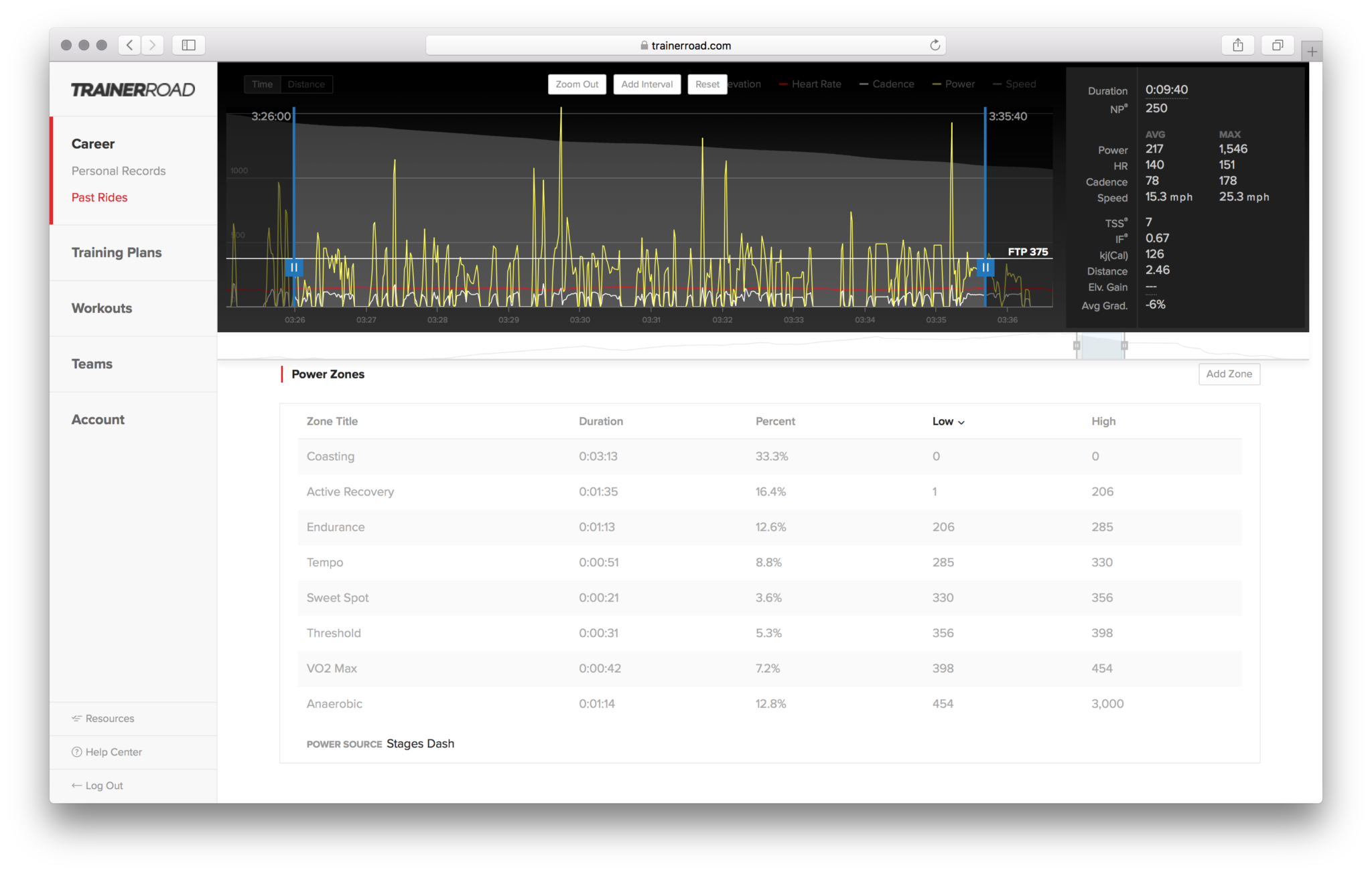
Coming out of the turns, you can see that Keegan is still concerned with maximizing his speed over every foot of the course. His hard-earned fitness leaves him unafraid to accelerate hard out of every turn, and by doing so he spends less time accelerating to his max speed, and more time sustaining that speed.
Line Choice: An Oft Forgotten Key of Sprinting
Keegan faced a three-rider sprint at the finish of the Carson City Off-Road. He out-sprinted Howard Grotts in a similar scenario at the Whiskey Off-Road, but this time he had Clif Bar Racing’s Ben Sonntag to worry about, and his sprinting ability was unknown to Keegan. The finish straight came shortly after a couple of 90º, left-right turns, making the first rider out of the last turn an almost guaranteed winner.
Keegan decided to avoid the uncertainty with an early move just before two turns to go. It was a strong move with three hard efforts over 1200 watts between turns. He intelligently covered the inside of the first turn he came across in his attack, but inadvertently left enough room on the inside of the next corner for Ben to sneak in and take the win.
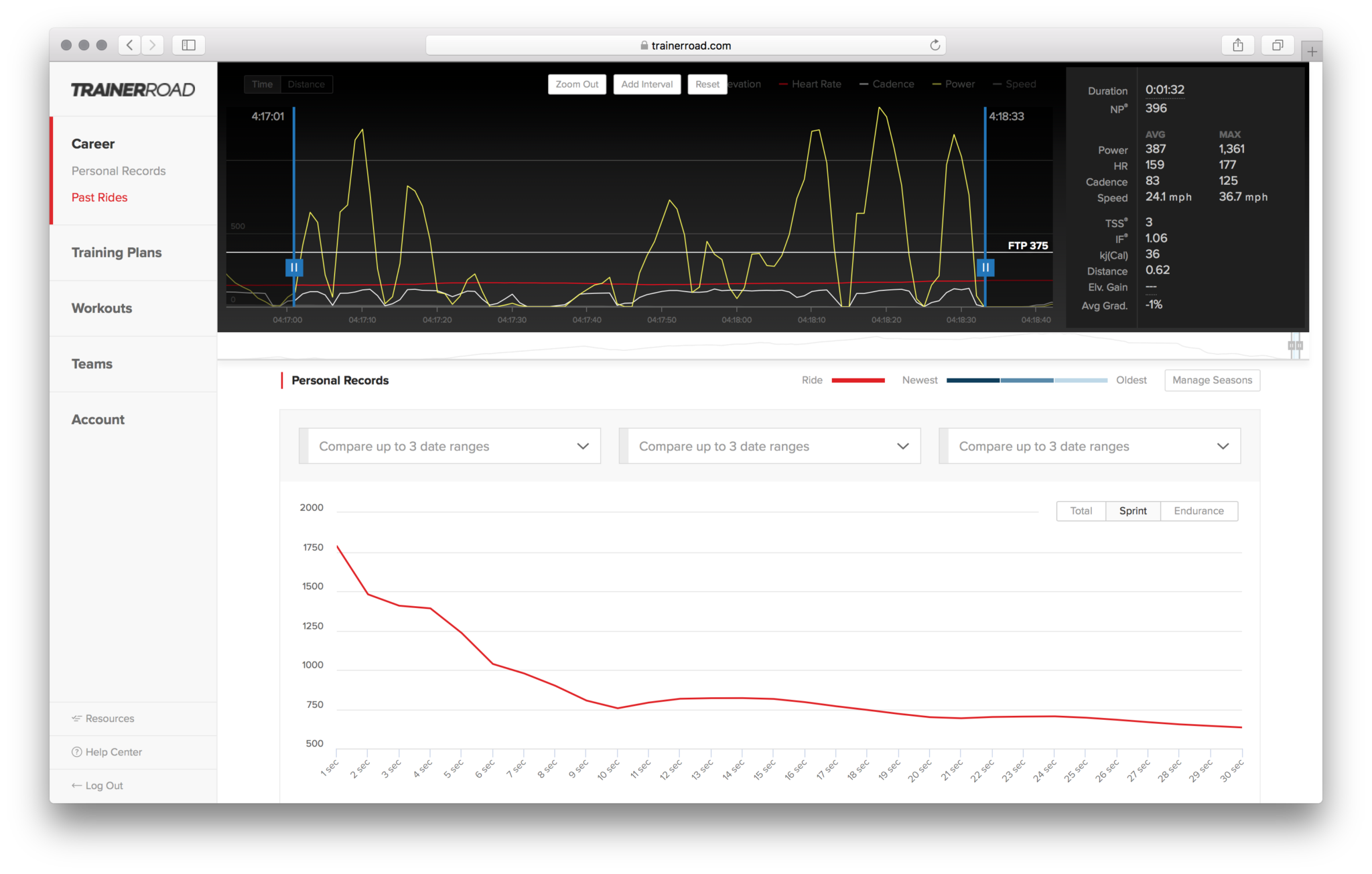
Sprinting ultimately comes down to power, but taking the proper line can give you the advantage you need, or safely block a fellow rider in a critical moment. This is a classic case of a tactical detail costing a rider, despite having the proper timing, and even the power to win.
Keeping all things necessary to win at the forefront of your mind is always tricky, but at the end of a demanding race like this, it is infinitely more complicated. For the last 90 seconds of this race Keegan had a Normalized Power of 400 watts with a peak power of 1,361 watts – an enormously impressive number for such a light rider after such a long race.
Time in Zones: Pros vs. Joes
World Cup Cross-Country racing are going to shorter, harder loops that aren’t open to the public, so it’s exciting to have these endurance races from Epic Rides that allow us to compare the performances of average riders to pro riders and see how exceptional they really are.
Looking at the time spent in each power zone for Keegan vs. Nate, you can see Keegan spent nearly 40% of his race “filling in the gaps” between hard efforts with Tempo, Sweetspot and Threshold work. In this respect, his effort is much more consistent than what you see from an average rider, with Nate having only 20% of his time spent in these zones.
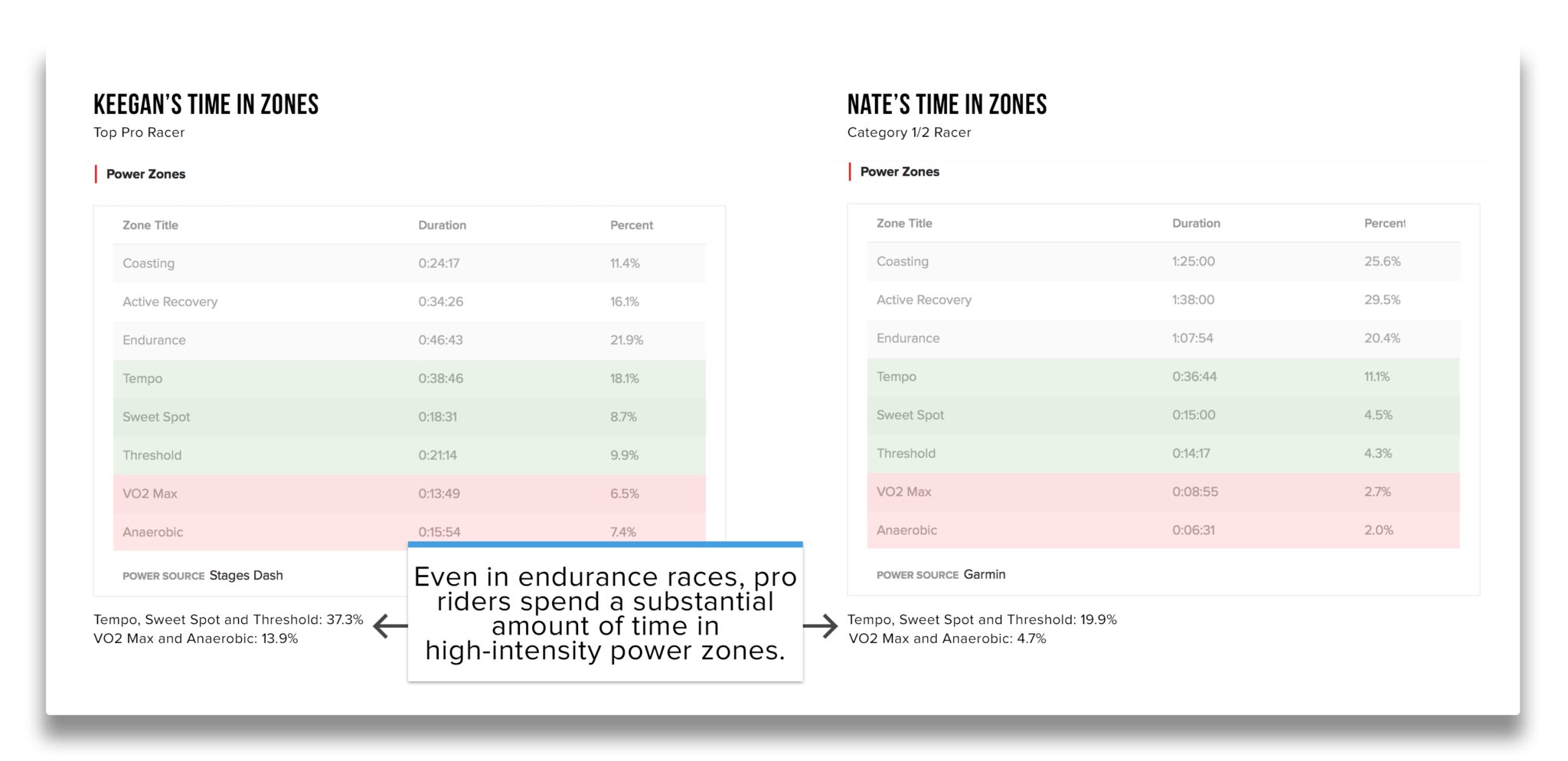
Even more interesting is that Keegan spent 14% of his time in the Anaerobic and VO2 Power Zones while Nate spent just under 5% of his time there.
What we can learn from this is how important high intensity interval work is for mountain bikers, even if they are planning to do an endurance race of 50 miles, and how hard these pro riders actually train and race. It certainly places them on another tier, but the way they get there is similar to that of an average rider. Hard work pays off, and Keegan and his fellow pro riders prove that.
For more cycling training knowledge, listen to the Ask a Cycling Coach — the only podcast dedicated to making you a faster cyclist. New episodes are released weekly.
